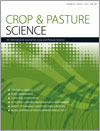CP12117Virus diseases of annual pasture legumes: incidences, losses, epidemiology, and management
Epidemics of plant viruses threaten the profitability of meat, wool and dairy industries by seriously reducing pasture feed-base productivity, e.g. widespread infection of subterranean clover pastures causes losses of more than AU$58 million per year to the Australian dairy industry alone. This article provides a comprehensive picture of current knowledge concerning the occurrence, losses caused, epidemiology, and management of virus diseases of annual pasture legumes growing in Australian pastures. Critical research and development gaps that need addressing urgently are identified.




